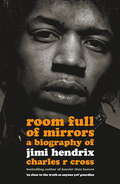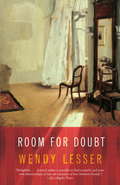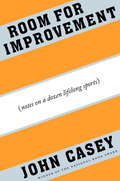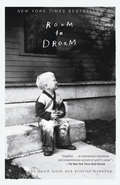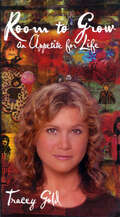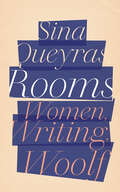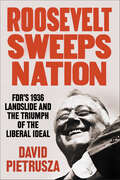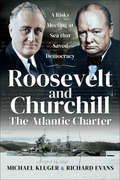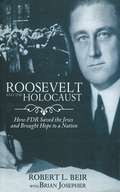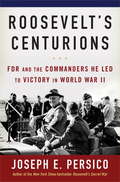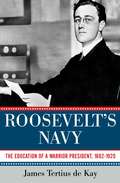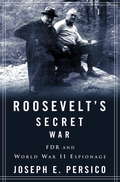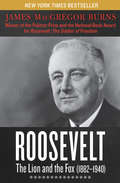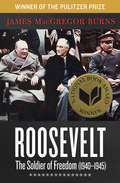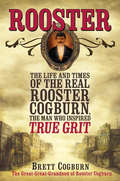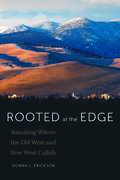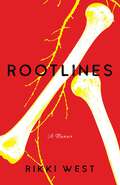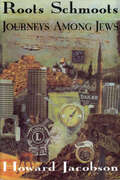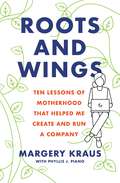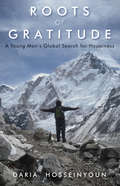- Table View
- List View
Room Full of Mirrors: A Biography of Jimi Hendrix
by Charles R. Cross'Charles R. Cross has got as close to the truth as anyone yet in his exhaustive and ground-breaking account of the life of the greatest guitarist in the history of rock.' Observer'Superb'Sunday TelegraphJimi Hendrix continues to fascinate, and sell huge quantities of albums, even 35 years after his death. Quite apart from his influence on musicians and fans, a large part of the appeal of his sensational life story lies in the thrill of the era whose values he came to stand for. The Sixties still exert a massive pull over pop culture and this is genuinely a book for anyone interested, not only in Hendrix but also in anything to do with the pop culture of the last 40 years.Meticulously researched and sensitively and beautifully written, this is a labour of love that reveals the nuances, foibles and tragedies of the human being behind the iconic image.This is the sweeping, authoritative and colourful biography that Jimi Hendrix and that his legions of fans, young and old deserves.
Room for Doubt
by Wendy LesserRoom for Doubtis Wendy Lesser's account of three separate but interlocking occasions for doubt: her stay in Berlin, a city she had never expected to visit; her unwritten book on the philosopher David Hume; and her long friendship with the writer Leonard Michaels, which constantly broke down and yet endured. Through this unusual journey, Lesser in the end shows us how, once examined, things are never quite what she thought they were.
Room for Improvement
by John CaseyFrom the author of the novel Spartina, which won the National Book Award and has established itself as a modern classic, comes a collection of essays that describe with tenderhearted candor and humor a lifetime's worth of addiction. No, not an addiction to booze or drugs, but an addiction to a more natural gratification: the joy of sport, exercise, and the sheer elation of being ready and willing to say yes to a challenge. Want to run a marathon? OK. Climb Mount Katahdin? Sure! How about canoeing the entire length of the Delaware River? Why not? Spanning more than fifty years of ambitious and sometimes peculiar endeavors, these essays take us along on some of Casey's greatest adventures: a twenty-six-day Outward Bound course in Maine during the dead of winter; being pinned by a two-hundred-pound judo instructor whose words, "Come on, white boy. Don't give up," encourage at least one more attempt at escape; leading a lost couple on a yacht through the rocky waterways of Narragansett Bay by a simple rowboat; and completing--on his seventieth birthday--a 70K marathon of his own devising that included rowing, bicycling, skating, Rollerblading, and finally, trotting the dog out for a mile. Be it a preoccupation with health, vanity, or just an indomitably playful sense of adventure, John Casey's Room for Improvement is a joyful self-portrait of a writer who loves going to extremes, just to find out what it's like once he gets there.From the Hardcover edition.
Room to Dream: A Life In Art
by David Lynch Kristine McKennaAn unprecedented look into the personal and creative life of the visionary auteur David Lynch, through his own words and those of his closest colleagues, friends, and family In this unique hybrid of biography and memoir, David Lynch opens up for the first time about a life lived in pursuit of his singular vision, and the many heartaches and struggles he’s faced to bring his unorthodox projects to fruition. Lynch’s lyrical, intimate, and unfiltered personal reflections riff off biographical sections written by close collaborator Kristine McKenna and based on more than one hundred new interviews with surprisingly candid ex-wives, family members, actors, agents, musicians, and colleagues in various fields who all have their own takes on what happened. Room to Dream is a landmark book that offers a onetime all-access pass into the life and mind of one of our most enigmatic and utterly original living artists. With insights into . . . Eraserhead The Elephant Man Dune Blue Velvet Wild at Heart Twin Peaks Twin Peaks: Fire Walk with Me Lost Highway The Straight Story Mulholland Drive INLAND EMPIRE Twin Peaks: The Return
Room to Grow: An Appetite for Life
by Julie McCarron Tracey GoldTracey Gold was well known to television audiences in the 1980s and ‘ 90s as the wholesome teenage sister on the long-running series Growing Pains. She co-starred for eight years alongside Kirk Cameron as brainy sister Carol Seaver in a picture-perfect American family. A working actress since the age of 4, she was a pretty and professional young star with a limitless future. But behind the smiles, Tracey was fighting the battle of her life. Photos of the shockingly thin Tracey faced readers from the cover of People magazine, revealing her struggle with an eating disorder that had plagued her for years. In this candid memoir, the actress recounts her offscreen troubles that viewers were unaware of at the time. Room to Grow is a moving account of a trip to hell and back. It is a journey of self-discovery and a chronicle of the very difficult lessons Tracey learned about coping in a society where emaciation is the ultimate ideal.
Rooms: Women, Writing, Woolf
by Sina QueyrasSHORTLISTED FOR THE QWF MAVIS GALLANT PRIZE FOR NON-FICTIONTHE GLOBE 100: THE BEST BOOKS OF 2022From LAMBDA Literary Award winner Sina Queyras, Rooms offers a peek into the defining spaces a young queer writer moved through as they found their way from a life of chaos to a life of the mindThirty years ago, a professor threw a chair at Sina Queyras after they’d turned in an essay on Virginia Woolf.Queyras returns to that contentious first encounter with Virginia Woolf to recover the body and thinking of that time. Using Woolf’s A Room of One’s Own as a touchstone, this book is both an homage to and provocation of the idea of a room of one’s own at the centre of our idea of a literary life.How central is the room? And what happens once we get one? Do we inhabit our rooms? Or do the rooms contain us? Blending memoir, prose, tweets, poetry, and criticism, Rooms offers a peek into the defining spaces a young queer writer moved through as they found their way from a life of chaos to a life of the mind, and from a very private life of the mind to a public life of the page, and from a life of the page into a life in the Academy, the Internet, and on social media."With Virginia Woolf alongside them, Queyras journeys through rooms literal and figurative, complicating and deepening our understanding of what it means to create space for oneself as a writer. Their hard-won language challenges us to resist any glib associations of Woolf’s famous ‘room’ with an easy freedom. Inspiring and moving, Queyras’s memoir testifies to Woolf’s continuing generative power."—Mark Hussey, editor of Virginia Woolf's Between the Acts (2011) and author of Clive Bell and the Making of Modernism (2021)"In this beautiful, perceptive book, Sina Queyras moves deftly between the words and wake of Virginia Woolf and their own formation as writer, lover, teacher, friend, and person. Rooms is expert in its depiction of personal and literary histories, and firmly aware of its moment of composition. Reading these pages, I was enticed by Queyras’s curiosity and openness, thrilled by the sharp edges of their anger. Tight prose, electric thinking, self-discovery – it’s all here, all abuzz. Rooms is alive." – Heather Christle, author of The Crying Book"It is impossible not to question the world as we thought we knew it by the end of this book. Sina Queyras painstakingly aims their extraordinary nerve and talent at Virginia Woolf’s idea of a room of one’s own: 'It’s a mistake to consider the room without all of its entanglements.' Taking Woolf’s cue, Queyras explores writing that is not world-building but something far more generous and transformative; as Woolf wrote, 'Literature is open to everybody.'" – CAConrad, author of AMANDA PARADISE: Resurrect Extinct Vibration
Roosevelt Sweeps Nation: FDR's 1936 Landslide and the Triumph of the Liberal Ideal
by David PietruszaWinner of the 2023 Independent Publisher Book Awards Gold Medal for US History From the acclaimed author of 1920: The Year of the Six Presidents and 1960: LJB vs JFK vs Nixon—The Epic Campaign that Forged Three Presidencies comes a dazzling panorama of presidential and political personalities, ambitions, plots, and counterplots; racism, anti-Semitism, anti-socialism, and anti-communism, and the landslide referendum on FDR’s New Deal policies in the 1936 presidential election. Award-winning historian David Pietrusza boldly steers clear of the pat narrative regarding Franklin Roosevelt’s unprecedented 1936 re-election landslide, weaving an enormously more intricate, ever more surprising tale of a polarized nation; of America’s most complex, calculating, and politically successful president, Franklin D. Roosevelt, at the very top of his Machiavellian game; and the unlocking of the puzzle of how our society, our politics, and our parties fitfully reinvented themselves. With in-depth examinations of rabble-rousing Democratic US Senator Huey Long and his assassination before he was able to challenge FDR in ’36; powerful, but widely hated, newspaper baron William Randolph Hearst, who blasted FDR’s “Raw Deal”; wildly popular, radical radio commentator Father Coughlin; the steamrolled passage of Social Security and backlash against it; the era’s racism and anti-Semitism; American Socialism and Communism; and a Supreme Court seemingly bent on dismantling the New Deal altogether, Roosevelt Sweeps Nation is a vivid portrait of a dynamic Depression-Era America. Crafting his account from an impressive and unprecedented collection of primary and secondary sources, Pietrusza has produced an engrossing, original, and authoritative account of an election, a president, and a nation at the crossroads. The nation’s stakes were high . . . and the parallels hauntingly akin to today’s dangerously strife-ridden political and culture wars.
Roosevelt and Churchill: A Risky Meeting at Sea that Saved Democracy
by Richard J. Evans Michael KlugerThe dramatic secret meeting between Churchill and FDR that forged their alliance against global fascism is brought to life in this WWII history.On August 14, 1941, Prime Minister Winston Churchill and President Franklin D. Roosevelt issued a joint declaration of goals for the world after the Second World War. The Atlantic Charter was a powerful statement against tyranny and an important display of the “Special Relationship” between the UK and the US.Roosevelt and Churchill: The Atlantic Charter tells the story behind this momentous document and the secret meeting that led to its creation. Churchill and Roosevelt barely knew each other when they met off the coast of Newfoundland aboard the USS Augusta. After a desperate dash across the U-boat infested Atlantic, Churchill spent four days at sea with Roosevelt, establishing both a personal friendship and an international alliance that would change the world.Exploring the lives of both men, the authors also include biographies of those who were vital to the process: Roosevelt’s Secretary of Commerce Harry Hopkins and foreign policy advisor Sumner Welles; and Churchill’s confidants Lord Beaverbrook, Lord Cadogan, and his son Randolph Churchill.
Roosevelt and Churchill: A Risky Meeting at Sea that Saved Democracy
by Richard J. Evans Michael KlugerThe dramatic secret meeting between Churchill and FDR that forged their alliance against global fascism is brought to life in this WWII history.On August 14, 1941, Prime Minister Winston Churchill and President Franklin D. Roosevelt issued a joint declaration of goals for the world after the Second World War. The Atlantic Charter was a powerful statement against tyranny and an important display of the “Special Relationship” between the UK and the US.Roosevelt and Churchill: The Atlantic Charter tells the story behind this momentous document and the secret meeting that led to its creation. Churchill and Roosevelt barely knew each other when they met off the coast of Newfoundland aboard the USS Augusta. After a desperate dash across the U-boat infested Atlantic, Churchill spent four days at sea with Roosevelt, establishing both a personal friendship and an international alliance that would change the world.Exploring the lives of both men, the authors also include biographies of those who were vital to the process: Roosevelt’s Secretary of Commerce Harry Hopkins and foreign policy advisor Sumner Welles; and Churchill’s confidants Lord Beaverbrook, Lord Cadogan, and his son Randolph Churchill.
Roosevelt and the Holocaust: How FDR Saved the Jews and Brought Hope to a Nation
by Robert L. Beir Brian JosepherThe year was 1932. At age fourteen Robert Beir’s journey through life changed irrevocably when a classmate called him a “dirty Jew.” Suddenly Beir encountered the belligerent poison of anti-Semitism. The safe confines of his upbringing had been violated. The pain that he felt at that moment was far more hurtful than any blow. Its memory would last a lifetime.Beir’s experiences with anti-Semitism served as a microcosm for the anti-Semitism among the majority of Americans. That year, a politician named Franklin Delano Roosevelt ascended to the presidency. Over the next twelve years, he became a scion of optimism and carried a refreshing, unbridled confidence in a nation previously mired in fear and deeply depressed. His policies and ethics saved the capitalist system. His strong leadership and unwavering faith helped to defeat Hitler.The Jews of America revered President Roosevelt. To a young Robert Beir, Roosevelt was an American hero. In mid-life, however, Beir experienced a conflict. New research was questioning Roosevelt’s record regarding the Holocaust. He felt compelled to embark on a historian’s quest, asking only the toughest questions of his childhood hero, including: How much did President Roosevelt know about the Holocaust? What could Roosevelt have done? Why wasn’t there an urgent rescue effort?In answering these questions and others, Robert Beir has done a masterful job. This book is graphically written, well-researched, and provocative. The portrait depicted of a man he once thought to be morally incorruptible amidst a circumstance of moral bankruptcy is truly unforgettable.
Roosevelt's Centurions: FDR and the Commanders He Led to Victory in World War II
by Joseph E. PersicoAll American presidents are commanders in chief by law. Few perform as such in practice. In Roosevelt's Centurions, distinguished historian Joseph E. Persico reveals how, during World War II, Franklin D. Roosevelt seized the levers of wartime power like no president since Abraham Lincoln during the Civil War. Declaring himself "Dr. Win-the-War," FDR assumed the role of strategist in chief, and, though surrounded by star-studded generals and admirals, he made clear who was running the war. FDR was a hands-on war leader, involving himself in everything from choosing bomber targets to planning naval convoys to the design of landing craft. Persico explores whether his strategic decisions, including his insistence on the Axis powers' unconditional surrender, helped end or may have prolonged the war. Taking us inside the Allied war councils, the author reveals how the president brokered strategy with contentious allies, particularly the iron-willed Winston Churchill; rallied morale on the home front; and handpicked a team of proud, sometimes prickly warriors who, he believed, could fight a global war. Persico's history offers indelible portraits of the outsize figures who roused the "sleeping giant" that defeated the Axis war machine: the dutiful yet independent-minded George C. Marshall, charged with rebuilding an army whose troops trained with broomsticks for rifles, eggs for hand grenades; Dwight Eisenhower, an unassuming Kansan elevated from obscurity to command of the greatest fighting force ever assembled; the vainglorious Douglas MacArthur; and the bizarre battlefield genius George S. Patton. Here too are less widely celebrated military leaders whose contributions were just as critical: the irascible, dictatorial navy chief, Ernest King; the acerbic army advisor in China, "Vinegar" Joe Stilwell; and Henry H. "Hap" Arnold, who zealously preached the gospel of modern air power. The Roosevelt who emerges from these pages is a wartime chess master guiding America's armed forces to a victory that was anything but foreordained. What are the qualities we look for in a commander in chief? In an era of renewed conflict, when Americans are again confronting the questions that FDR faced--about the nature and exercise of global power--Roosevelt's Centurions is a timely and revealing examination of what it takes to be a wartime leader in a freewheeling, complicated, and tumultuous democracy.Advance praise for Roosevelt's Centurions "[A] sweeping, top-down account of 1939-45 from the point of view of FDR, his cabinet and his leading generals and admirals. . . . Long wars demand long books, but these are 550 pages of lively prose by a good writer who knows his subject."--Kirkus Reviews "When I was a boy growing up in the South Bronx, my heroes were Roosevelt's centurions. As a soldier for thirty-five years, I made them my mentors and models. These men were heroes. They were fallible and occasionally vain, but we were certainly blessed to have such Americans leading the Greatest Generation during the world's greatest conflict. Of course, the greatest centurion of them all was FDR himself, who knew how to lead his commanders, stroke their egos, and get the best from them, yet never left any doubt as to who was commander in chief. Joe Persico, my valued collaborator on my memoirs, has brought his formidable talents to bear to bring the centurions to life. He is at the top of his game in this defining classic."--Colin L. Powell, General, U.S. Army (Retired).
Roosevelt's Navy
by James Tertius de KayFDR as never seen before: His formative years as Woodrow Wilson's Assistant Secretary of the Navy, evolving from political neophyte to visionary leader This is the story of a very different Franklin Delano Roosevelt from the one usually found in the history books. This is a much younger, untested FDR, a physically active, pre-polio FDR, as seen during his early years in Washington, learning the complexities of gaining and exercising power as Woodrow Wilson's ambitious Assistant Secretary of the Navy. He arrives in Washington as a somewhat shallow, inexperienced political neophyte possessed of little more than a famous name, but by the time he leaves the Navy eight years later he will have transformed himself into a seasoned professional, wise to the ways of power, a visionary ready and eager to take his place on the world stage. FDR's early years in Washington also include the most tumultuous period in his personal life, when, caught in a difficult marriage, he is forced to choose between his own personal happiness and his towering political ambitions. He must deal at close quarters with Congress, with the Administration, with the military, with big business. Lastly, but crucially, he confronts himself, learning something about his potential, his limitations, and his ambition. Such self-knowledge is perhaps the most valuable single gift that a leader of a democracy can hope for.
Roosevelt's Navy: The Education of a Warrior President, 1882-1920
by James Tertius de KayFDR as never seen before: His formative years as Woodrow Wilson's Assistant Secretary of the Navy, evolving from political neophyte to visionary leader. This is the story of a very different Franklin Delano Roosevelt from the one traditionally found in the history books. This is a much younger, untested, pre-polio FDR, learning the complexities of gaining and exercising power as Woodrow Wilson's ambitious Assistant Secretary of the Navy. He arrives in Washington as an inexperienced political amateur possessed of little more than a famous name, but by the time he leaves the Navy eight years later he will have transformed himself into a seasoned professional, wise to the ways of power, a visionary ready and eager to take his place on the world stage. FDR's early years in Washington also include the most tumultuous period in his personal life, when, caught in a difficult marriage, he is forced to choose between his own personal happiness and his political ambitions. He must deal at close quarters with Congress, with the Administration, and with the military. Lastly, but crucially, he confronts himself, learning something about his potential, his limitations, and his growing ambition to become president of the United States.
Roosevelt's Secret War: FDR and World War II Espionage
by Joseph E. PersicoDespite all that has already been written on Franklin Delano Roosevelt, Joseph Persico has uncovered a hitherto overlooked dimension of FDR's wartime leadership: his involvement in intelligence and espionage operations.Roosevelt's Secret War is crowded with remarkable revelations:-FDR wanted to bomb Tokyo before Pearl Harbor-A defector from Hitler's inner circle reported directly to the Oval Office-Roosevelt knew before any other world leader of Hitler's plan to invade Russia-Roosevelt and Churchill concealed a disaster costing hundreds of British soldiers' lives in order to protect Ultra, the British codebreaking secret-An unwitting Japanese diplomat provided the President with a direct pipeline into Hitler's councilsRoosevelt's Secret War also describes how much FDR had been told--before the Holocaust--about the coming fate of Europe's Jews. And Persico also provides a definitive answer to the perennial question Did FDR know in advance about the attack on Pearl Harbor?By temperament and character, no American president was better suited for secret warfare than FDR. He manipulated, compartmentalized, dissembled, and misled, demonstrating a spymaster's talent for intrigue. He once remarked, "I never let my right hand know what my left hand does." Not only did Roosevelt create America's first central intelligence agency, the OSS, under "Wild Bill" Donovan, but he ran spy rings directly from the Oval Office, enlisting well-placed socialite friends. FDR was also spied against. Roosevelt's Secret War presents evidence that the Soviet Union had a source inside the Roosevelt White House; that British agents fed FDR total fabrications to draw the United States into war; and that Roosevelt, by yielding to Churchill's demand that British scientists be allowed to work on the Manhattan Project, enabled the secrets of the bomb to be stolen. And these are only a few of the scores of revelations in this constantly surprising story of Roosevelt's hidden role in World War II.
Roosevelt: The Lion and the Fox (Roosevelt #1940)
by James MacGregor Burns&“A brilliant full-length portrait of Franklin Roosevelt the politician&”—the first in an award-winning two-volume biography (The Christian Science Monitor). Franklin Delano Roosevelt was the longest serving president in United States history, reshaping the country during the crises of the Great Depression and World War II. But before his ascension to the presidency, FDR laid the groundwork for his unprecedented run with decades of canny political maneuvering and steady consolidation of power. In this remarkable New York Times–bestselling biography, Pulitzer Prize–winning historian James MacGregor Burns traces FDR&’s rise and the peculiar blend of strength and cunning that made him such a uniquely transformative figure. Weaving together lively narrative and impressive scholarship, Burns reconstructs his youth and education at Groton and Harvard, his relationships with his cousins Theodore and Eleanor, his immersion in New York State politics, and his rise to national prominence, all the way through his first two terms as president, which saw the historic New Deal take hold and the drumbeats of World War II begin. Originally published in 1956, The Lion and the Fox was among the first studies of Roosevelt—and it remains a landmark record of his ambitions, talents, and flaws. Hailed by the New York Times as &“a sensitive, shrewd, and challenging book&” and by Newsweek as &“a case study unmatched in American political writings,&” Burns&’s stunning achievement is the life story of a fascinating political figure.
Roosevelt: The Soldier of Freedom (1940-1945) (Roosevelt #2)
by James MacGregor BurnsThe &“engrossing&” Pulitzer Prize and National Book Award–winning history of FDR&’s final years (Barbara Tuchman). The second entry in James Macgregor Burns&’s definitive two-volume biography of Franklin Delano Roosevelt begins with the president&’s precedent-breaking third term election in 1940, just as Americans were beginning to face the likelihood of war. Here, Burns examines Roosevelt&’s skillful wartime leadership as well as his vision for post-war peace. Hailed by William Shirer as &“the definitive book on Roosevelt in the war years,&” and by bestselling author Barbara Tuchman as &“engrossing, informative, endlessly readable,&” The Soldier of Freedom is a moving profile of a leader gifted with rare political talent in an era of extraordinary challenges, sacrifices, heroism, and hardship.
Rooster's Gold: A Novel
by A. Alan IsaacsRe-experience historical fact as it is woven into the fictional fabric of the Hawkins family with Xander Hawkins, an extremely wealthy man from Tennessee, who engages a New York lawyer to create a Trust Fund to provide for the continuation of his dream: the encouragement, education, and care of orphans.A. Alan Isaacs invites readers to sit in Xander&’s study alongside the lawyer as he listens to stories about how the Hawkins family discovered a love for orphans and an unimaginable treasure! Over several days, the lawyer learns how more than 200 years of &‘Journaling&’ from Xander&’s ancestors continues to influence his approach to life. Along the way, readers can snap pictures of QR Codes embedded throughout Rooster&’s Gold to effortlessly connect the written word to an internet-based resource. Readers can also fact-check Xander&’s stories as his relatives encounter several of history&’s heroes, such as Davy Crockett, Theodore Roosevelt and his Rough Riders, and many more!After returning from the Spanish-American war, Rooster&’s son learns that orphaned and abandoned children are being put on trains in New York City and &‘whistle-stopped&’ across the United States to live and work on farms to produce crops for the country&’s exploding population. Witness how the stories of these Orphan Train Children profoundly impact the Hawkins&’ family—and the New York lawyer.
Rooster: The Life and Times of the Real Rooster Cogburn, the Man Who Inspired True Grit
by Brett CogburnThe True Story Behind True GritImmortalized in the classic novel and films, the real "Rooster" Cogburn was as bold, brash, and bigger-than-life as the American West itself. Now, in this page-turning account, Cogburn's great-great-grandson reveals the truth behind the fiction--and the man behind the myth. . . He was born in 1866 in Fancy Hill, Arkansas, the descendant of pioneers and moonshiners. Six foot three, dark eyed, and a dead shot with a rifle, Franklin "Rooster" Cogburn was as hard as the rocky mountain ground his family settled. The only authority the Cogburn clan recognized was God and a gun. And though he never packed a badge, Rooster meted out his own brand of justice--taking on a posse of U. S. deputy marshals in a blazing showdown of gunfire and blood. Now a wanted man, with a $500 reward on his head, Rooster would ultimately have to defend himself before a hanging judge. Proud, stubborn, fearless, and ornery to the bitter end. A fascinating portrait of a true American icon, Rooster shows us the making of a legend--fashioned by Arkansas newspaperman Charles Portis with bits and pieces of historical figures, including Deputy Reuben M. Fry, one-eyed Deputy Marshal Cal Whitson, Joseph Peppers (Lucky Ned), Joseph Spurling (Mattie Ross's grandfather) and bank robber Frank Chaney (scar-faced Tom Chaney. ) Behind it all stood a man named "Rooster," with two good eyes and a tale all his own. With never-before-seen photosSome folks are just born to tell tall tales. Brett Cogburn was reared in Texas and the mountains of Southeastern Oklahoma. He was fortunate enough for many years to make his living from the back of a horse, where on cold mornings cowboys still straddled frisky broncs and dragged calves to the branding fire on the end of a rope from their saddlehorns. Growing up around ranches, livestock auctions, and backwoods hunting camps filled Brett's head with stories, and he never forgot a one. In his own words: "My grandfather taught me to ride a bucking horse, my mother gave me a love of reading, and my father taught me how to hunt my own meat and shoot straight. Cowboys are just as wild as they ever were, and I've been damn lucky to have known more than a few. " The West is still teaching him how to write. His first novel, Panhandle, will be published in November 2012. Brett Cogburn lives in Oklahoma with his family.
Rooted at the Edge: Ranching Where the Old West and New West Collide
by Donna L. EricksonRooted at the Edge paints a portrait of a ranching community in a threatened landscape steeped in history, conflict, and beauty. In this narrative nonfiction work, Donna L. Erickson explores the hilly skirt of ground at the northern boundary of Missoula, Montana, separating the town from the wilderness beyond. The North Hills region represents the critical—and often highly personal—issues at play at the edge of many western towns. The urban-rural fringe is both valuable and vulnerable. Across the West rural lifestyles are increasingly compromised by suburbanization, economic hardship, and family dynamics; a way of life and a way of work are vanishing. Ranchland may be simultaneously cherished by a family for the life its members have made there and coveted by urban neighbors for open space. Community residents may love a place for its scenery and wildlife habitat while others wish it converted to a commercial parking lot. Complex ecological relationships can be bulldozed in a single afternoon. And the threats of climate change and shifting populations compromise the edge even more. In the tension between love and loss, Erickson wrote this story of a landscape&’s soft contours, piney ridges, shady draws, and grassy slopes, and its potential disappearance under an expanding city. Rooted at the Edge conveys, in a way that statistics cannot, what&’s at stake when ranches at the urban fringe are threatened.
Rooted in the Earth, Rooted in the Sky: Hildegard of Bingen and Premodern Medicine
by Victoria SweetRooted in the Earth, Rooted in the Sky is a detailed study of the medicine of Hildegard of Bingen, a medieval mystic, theologian and composer, who also wrote a practical medical text. Although there has been an explosion of interest in Hildegard's music, theology, illuminations and medicine in the last two decades, this is the first book to use her remarkable text to revise not only our conception of Hildegard but also of premodern medicine itself. It does so by contextualizing her work with primary and secondary historical sources, unedited manuscripts, anthropological and archeological evidence and linguistic analyses. Its surprising conclusion is that the premodern body was more like a plant than a machine or a computer program, and the physician more like a gardener than a mechanic or a computer programmer.
Rootlines: A Memoir
by Rikki WestRikki and her sister, Linda, fell out with one another four months ago. They are not speaking when Linda emails that she has lethal abdominal tumors, that her only hope of survival is a total bone marrow replacement. Linda claims Rikki is too old to donate, and explains there’s only a slight chance she is a good match anyway—but Rikki refuses to accept that. Despite the wounding between them, Linda’s email ignites a wild aspiration in her sister: she will become the perfect donor, the perfect match, with the healthiest, most vigorous cells possible. She rises with intent to heal herself, her sister, and their rootlines, the patterns formed in their family of origin that have quietly shaped their lives. Rikki walks through the science while confronting dogma that limits how mind can transform body. She builds herself into a stem cell factory using Muay Thai kickboxing and vegetarian nutrition. Working through childhood wounds and mental limits with meditation and yoga, she finds her own power, as well as ways to show up for Linda and walk with her from the edge of death to a new life. Together, the two sisters beat the lymphoma—and, as they rediscover the intimacy and love of their innocent childhood, heal the intertwined roots of their family pain.
Roots Schmoots: Journeys Among Jews
by Howard JacobsonWherever there is a Jew there is a journey; for a Jew to go travelling in search of his Jewishness is therefore doubly Jewish. When fast-breaking political events forced British novelist Jacobson (Peeping Tom) to put off a trip to Lithuania planned as a search for his Jewish roots, he accepted an offer from the BBC to visit Jewish communities around the globe instead. This informed and witty account of his experiences deals with the wide variety of contemporary Jewish life, as well as with how Jacobson's observations affected his own concept of what it means to be a Jew. Riding an emotional roller coaster, he witnessed the hostility between Jews and African Americans in New York City, attended services in a gay synagogue in California and found his basic cynicism about religion reinforced after he spent time with Orthodox Jews in Israel, although his spirits were lifted by a visit to an idealistic, tolerant Israeli kibbutz. His journey concluded with the postponed trip to Lithuania, where the author found virulent anti-Semitism. The book has been adapted for a forthcoming BBC/PBS documentary.
Roots and Rhythm: A Life in Music
by Charlie PeacockA beautifully crafted memoir unveiling the ancestral, musical, and spiritual roots of Grammy Award-winning music producer Charlie Peacock. In this artful memoir, Grammy Award–winning music producer Charlie Peacock flexes his literary chops and gives readers the gritty backstage stories they crave: biographical anecdotes, geeky trivia, and how the hits were written and recorded (from jazz to rock and pop). Threaded throughout is Peacock&’s unique ancestral and spiritual story—the roots. Like Coltrane, Dylan, and Bono before him, Peacock reveals a Christ-affection while refusing genres too small for his music. Peacock, the great-grandson of a Louisiana fiddler, is an American musical polymath. He&’s been the young jazz musician sitting at the feet of trumpeter Eddie Henderson and pianist Herbie Hancock; the singer-songwriter plucked from the Northern California punk/pop underground by legendary impresarios Bill Graham and Chris Blackwell; a pioneering, innovative contributor to the nascent rise of gospel rock in the 1980s; and the genre-busting producer behind such diverse artists as Al Green, Ladysmith Black Mambazo, Chris Cornell, Audio Adrenaline, The Civil Wars, Switchfoot, Turtle Island Quartet, and John Patitucci.Roots and Rhythm includes Peacock&’s seminal NorCal days, the story of indie labels Exit and re:think, his first decade as a Nashville producer (1989–1999), and his essential role in the 21st-century folk/Americana boom (The Civil Wars, Holly Williams, The Lone Bellow). While his exploits and achievements grace the book (including the story of Amy Grant&’s &“Every Heartbeat&” and the evergreen &“In the Light&”), Peacock is hardly the only character. Instead, he writes as a Joan Didion-style essayist, weaving together a quintessential American story. Beat poet Gary Snyder, evangelist Billy Graham, producer T Bone Burnett, saxophonist Wayne Shorter, and writers Wendell Berry and Isabel Wilkerson all appear in this sweeping tale where ancestry, migration, teenage love, Jesus, and Miles Davis collide. The book is an invitation to all, including aspiring musicians: embrace the roots and rhythm of our own lives, letting the music and God&’s insistent love lead us to gratitude and wonder.
Roots and Wings: Ten Lessons of Motherhood that Helped Me Create and Run a Company
by Phyllis J. Piano Margery KrausA child of immigrants, Margery Kraus knew the value of hard work from an early age. Graduating from college before she had finished high school, she learned to be a risk taker. As a young wife and mother coming of age in the 1960s, she faced plenty of people who told her, &“You can&’t do that.&” But in the end, she did: she founded APCO Worldwide, a global consulting firm headquartered in Washington, DC, specializing in public affairs, communication, and business consulting for major multinationals. Under her leadership, the company grew from nothing to almost $150 million in revenues. In Roots And Wings, Kraus shares the ten lessons she learned from motherhood and leadership that guided her along the way—an inspiration to all seeking to overcome obstacles, achieve career and personal success, and do the right thing.
Roots of Gratitude
by Daria HosseinyounIf you had it all, what would you do? At the age of 20, Daria felt he had everything and nothing. To outside observers, he had it all: a loving family, a beautiful girlfriend, materials riches, and a family business waiting for him to assume leadership, but there was a gnawing feeling that something was missing. When Daria's friend dies at the age of 21, he is shaken at the roots. Witnessing death for the first time, he questions every aspect of life including the origins of suffering and happiness. He wonders why he is following the herd in a life-consuming race towards emptiness. Hungry for meaning, he leaves everything he's ever known to expose himself to the reality of the world through his own experience. His journey takes him on an expedition through the countryside of Mongolia where he learns of generosity, surfing the coasts of Bali, experiences the essence of martial arts from Aikido masters and back-country snowboarding in Japan. He ventures through India, learning yoga and meditation, and finds a prominent monk in Nepal who "freezes" him, shifting his understanding of the world around him. With his new found knowledge, he sets out on a 12-day trek to witness the colossal peaks of the Everest region, where his experience is nothing short of the divine. Daria's path leads him to snakes and stitches, avalanches and wolves, death and rebirth in order to return to society and impart one message: a new-found understanding. Daria makes no claims to be a saint or a revolutionary. He faces the same dilemmas that many of us face on a daily basis and through his mistakes gains a better understanding of who he is and how he wants to live his life. Roots of Gratitude presents an inspirational and captivating journey of a young man's search for his true self. By sharing his experiences with readers - his struggles between following his dreams and societal expectations, and his magnificent spiritual awakening - he imparts courage to follow our hearts and to experience the world for ourselves, so that we may all find a way to our true (and grateful) selves.
